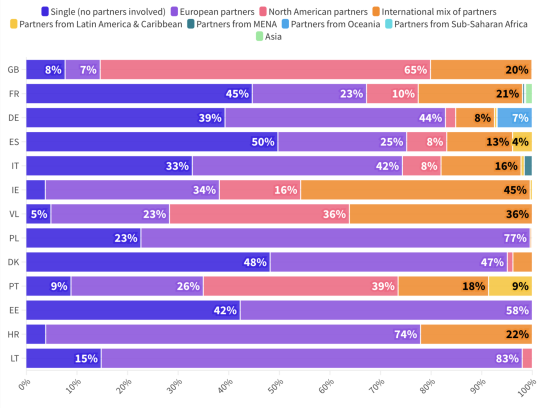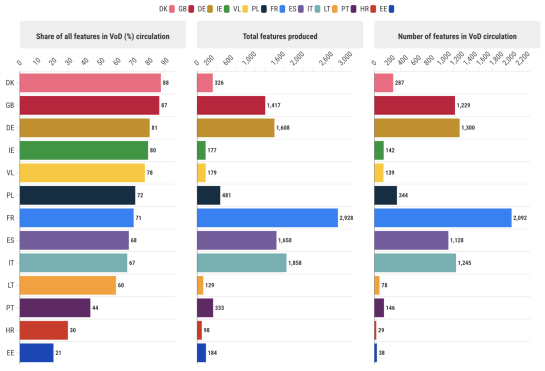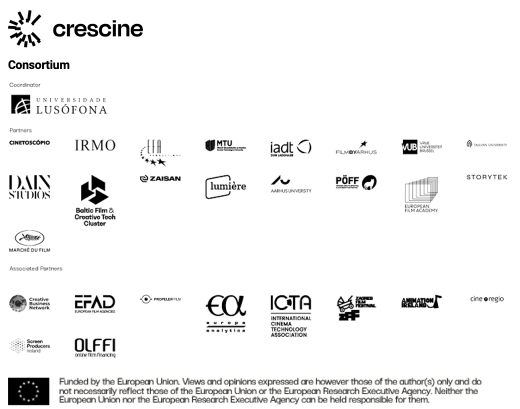30 April 2024
Ivana Kostovska, Jakob Isak Nielsen, Cathrin Bengesser, Marius Øfsti, Ana Falcon, Ulrike Rohn
What are the export dynamics of films from small European markets? How can films from small European markets enhance their reach of broader global audiences? The CresCine project will soon publish an interactive visual report, titled ‘Small European Film Markets: Portraits and Comparisons.' The data shows that local film industries in small countries and regions cannot be sustained by home audiences alone. This is why the film industries and policy stakeholders in these markets must develop different strategies for funding and producing films.
The forthcoming report provides in-depth research on seven small European markets (Estonia, Croatia, Denmark, Flanders in Belgium, Ireland, Lithuania, and Portugal), and compares them with six large European markets (France, Germany, Italy, Spain, the UK, and Poland). However, in some aspects, the insights and lessons learned are valuable to other markets in Europe and beyond. It features over 60 interactive data visualisations that industry and policy stakeholders can use to compare markets, delve into export patterns in specific export territories, and explore a wealth of data across the value chain of film production, funding, distribution, exhibition, and reception.
The report, led by Aarhus University as one of the CresCine partners, explores a broader range of questions and offers extensive data analysis. However, this policy brief is dedicated solely to discussing insights on film export and international circulation.
Highlights
|
|
|
The research project CresCine started in 2023 and will run until 2026. It is funded by the European Union’s Horizon Europe research programme (Grant number: 101094988). The consortium consists of 16 research and industry organizations in 10 countries. The research project’s leader Manuel Damasio from Lusofona University in Lisbon highlights that “the economic and cultural importance of local film industries in small countries and regions is why the CresCine project has been investigating what makes small film-producing European countries and regions special and how they cope with the competition from large countries like the USA.” More information on the participating organisations and the project’s output can be found online at www.crescine.eu.
1. What is covered in the latest CresCine report?
The CresCine research project aims to enhance the competitiveness and cultural diversity of the European film industry. It studies seven small film producing countries and regions: Ireland, Denmark, Estonia, Lithuania, Portugal, Croatia, and Flanders in Belgium. The choice of markets covered in the project reflects not only different geographical positions, but also countries and regions with very different film production cultures. Jakob Isak Nielsen from Aarhus University, who has been leading the latest report explains: “The Baltic regions, for example, have seen a huge transformation of their film production and cinema infrastructure after the end of the Soviet Union. Croatia has developed a significant production service economy attracting foreign productions like The Hitman’s Wife’s Bodyguard (2021) to the country.” His colleague Marius Øfsti, who has been investigating how films from small countries perform at festivals exemplifies that “Denmark and Flanders have recently had productions with high critical acclaim and international export like Oscar-winner Another Round (2020) or Close (2022) which won Grand Prix at Cannes.”
The report traces the development of the seven selected small markets over nine years, from 2014 to 2022. During this period, these markets experienced the expansion of global streaming services as well as the impact of the Covid-19 pandemic and the economic downturn on both film production and cinemas. Cathrin Bengesser from Aarhus University explains that although films from small countries are often well represented on local services “most globally operating streaming services like Netflix do not feature a large choice of films from small markets. This is a problem because the market leaders’ choices affect the diversity of film culture audiences in Europe have easy access to.”
Additionally, the report provides an analysis of the competitiveness outlook in large markets, including a comparative analysis of CresCine markets and six other large markets. Ivana Kostovska from imec-SMIT, Vrije Universiteit in Brussels has been investigating the patterns of export of films from 13 European markets (CresCine and large markets) in key export territories. She outlines that “the large markets typically engage with more diverse production partners compared to most of the small markets, highlighting the strategic value of partnerships for export.” The analysis of data from the Netflix Engagement Report in this part of the analysis shows that Danish films commissioned by Netflix are the most viewed from the CresCine markets; however, the streamer has not commissioned any films from some of the smaller markets.
Based on analyses of the ‘Big Five’ markets and Poland, Kostovska and her colleagues Ulrike Rohn and Ana Falcon from Tallinn University conclude that the large markets are much more strategically oriented towards export than most of the small countries. Films from the US, however, dominate the European cinematic landscape and Ana Falcon from Tallin University points out “US films’ strong orientation towards franchises that pushes their success in European cinemas. 87 of the top 100 US films in the 13 European markets we studied were based on existing IP.”
2. How do export dynamics and partnership networks vary across the 13 markets?
According to our data analysis, collaborations with European partners proved to be an important element for enhancing the international circulation of films for both small CresCine and the large markets. Namely, the cluster of films featuring collaborations with European partners led the way in export admissions for both CresCine and the large markets analysed. Exceptions include the UK and Portugal, where the highest share of admissions was achieved with films involving North American partners. Ireland and Flanders attained their highest share of admissions in the export markets analysed through collaborations with a diverse mix of international partners. While films from the CresCine markets often do not match the high admissions of films from large markets in different export regions, there are some exceptions. In the Latin America and Caribbean region, as well as in Oceania, Ireland outpaced both Italy and Poland in cinema admissions. Similarly, Denmark, Flanders, and Ireland surpassed Poland in admissions in the EU and UK. In some export markets, films from CresCine markets recorded higher average admissions compared to those from larger markets. In fiction films exported by large markets, drama and comedy were the most popular genre tags.

Visualisation 1: Breakdown of non-national admissions by producing partners involved
Source: Authors’ calculation based on European Audiovisual Observatory
Exported feature films produced between 2014-2022 are grouped into nine clusters, distinguishing between single productions and films where different partners are involved. Films recording fewer than 1,000 non-national admissions were excluded from the analysis.
The insights from the six large markets analysed in the report – Italy, Germany, France, Spain, Poland, and the UK – offer strategic points on competitiveness and export for smaller CresCine markets. The ‘Big Five’ markets analyse and assess export performance of domestic films through different indicators. Italy recognises three ‘engines of export’: co-productions, global SVoD providers, and international distributors. It is understood that increasing co-productions and diverse partnerships is important for boosting film exports. In France, approximately 75% of the films produced in 2022 were co-productions, underlining the consideration that French cinema would be weakened without co-productions. Analysis of export performance in large markets includes examining market trends through various indicators, such as key export markets, turnover in different territories, sales performance according to buyers, reception of different genres, and share of films in VoD catalogues.
The potential for films to be exported is strongly linked to language as a factor. The international success of French cinema is often powered by English-language films with a global audience in mind, with the French director Luc Besson playing a key role in several films with global appeal. For Spain, global streamers are important buyers of local films and series.
3. What are the drivers of international admissions of CresCine films?
Analysing the Top performing films (2014-2022) from the CresCine sample in international markets and comparing them to top-performing titles in domestic markets as well as to total output of films has produced several export indicators. Certain genres stand out as performing better internationally than domestically: adventure, horror, sci-fi, fantasy, mystery. Genre hybridity as such is also more prevalent in films that perform well internationally and co-productions also travel more often, particularly to markets involved in the production. If a co-production partner is from a large international market, it can also open doors to substantial international admissions in large international markets both within and outside of Europe. Other characteristics include:
- Productions in English and/or animation films dubbed into local languages.
- Films that share languages with neighbouring markets.
- Films directed by internationally recognized auteurs.
- Films starring internationally recognized actors.
- Many highly successful animation films clearly associated themselves with or based their stories on internationally recognized popular cultural phenomena.
Many internationally successful films are not strongly anchored culturally in the market in which they are produced. Some are more anchored in a specific non-domestic culture, e.g. the US. Others are more non-specific thus creating texts that are more ‘open,’ allowing international audiences to read their own socio-cultural dispositions into the text. On the other hand, there are relatively few examples of the ‘the more local, the more global’ films, i.e. films so steeped in the cultural specificity of a domestic market as to make this an attraction in its own right.
Our analysis shows that not all our ecosystems are strong exporters of films, but Flanders, Ireland and Denmark have very strong track records regarding exports of animation films to Europe as well as to Asia, Latin America, and North America. Family and children-oriented animation films do well in international markets, but one of the best performing recent documentary films both in terms of admissions and awards, Flugt (DK, SE, NO, FR, US, ES, IT, GB 2021), is also – and very idiosyncratically so – an animation film. On average, the CresCine ecosystems export films to 15 different non-domestic markets per year.
A genre perspective on the top 20 films domestically and internationally suggests that certain genres from CresCine ecosystems ‘travel’ better internationally. Adventure, horror, sci-fi, fantasy, mystery, family, and the broad category of drama stand out as performing better internationally than domestically.
4. Circulation of films on streaming services and success of Netflix titles
VoD services are an important circulator for films from small ecosystems with highly developed VoD markets. Therefore, we can expect films’ potential for VoD circulation to grow in line with the uptake of VoD in the respective country.
A similar share of films from small and large markets circulates on VoD, but the differences between the individual countries are vast and – of course – small markets have a lower output of productions to circulate than the large markets. Films from markets with clearer theatrical export orientation also circulate in more countries on VoD, but national and international box office performance is not the only factor behind wide VoD circulation. Recognizable stars and strong genre orientation can also propel films from small nations across VoD catalogues and countries. Globally operating subscription VoD services (particularly Netflix and Disney+) only offer a small selection of films from the seven CresCine ecosystems, which make domestic and regional European VoD players the more important buyers of VoD rights to films from the studied small ecosystems to date.
On average, feature films for large markets circulated in nine markets out of the 26 European countries, which was more compared to the CresCine markets. UK feature films showed the highest level of circulation, in 14 markets on average. Italian films had the lowest level of circulation in the catalogues of 26 European countries (six on average). In October 2023, French and Spanish films on average circulated to nine markets, while German and Polish features travelled to seven markets. In comparing the shares of feature film titles, it is evident that certain Crescine markets have a higher share of features in VoD circulation than the larger markets. Denmark, when compared to the other 12 markets, has the highest share of feature films in VoD circulation.

Visualisation 2: Comparison of features in VOD circulation Crescine and Large markets
Source: Authors’ calculation based on European Audiovisual Observatory
The report also compares the performance of films from the CresCine markets and from the six large markets based on analysis of data released by Netflix in the Netflix Engagement Report on what subscribers are watching combined with data from Netflix's top 10 lists of the most-watched TV and films. We focused on analysing the total number of times a film was watched and the average number of views per title. Netflix reports viewership in hours, which we used as a basis to calculate the number of times a film was viewed, considering the film's length. Considering the total number of views, from the 13 markets analysed, UK films commissioned by Netflix were the most watched among subscribers. Italian films had the lowest number of views among films from the large markets. Among films from the CresCine markets, Danish productions were the most viewed, followed by Flemish and Irish works. The list does not include any films commissioned from Croatia, Estonia, or Lithuania. The streamer has not commissioned any films in these three markets in the period of analysis.
5. What else you can find in the report?
| Volume of production from CresCine ecosystems |
| The scale of domestic productions is an important factor for determining the sustainability of a domestic film production sector. The analysis of fiction and documentary productions shows considerable differences between the CresCine ecosystems in terms of the overall output understood as 100% national films and majority co-production as well as compared to minority co-productions. Some markets in our sample have a more pronounced co-production culture. Considering the total fiction productions between 2014 and 2022, Croatia and Flanders show the clearest orientation towards minority co-productions, which account for 42% and 35% shares of their total fiction production respectively. |
| Festival awards |
| Croatia and Denmark had the highest awards-to-nominations ratio of all Crescine markets, with 20%. Danish and Irish films received nine and eight Academy Awards nominations, while Flemish films were nominated once. Danish films also received the most European Film Awards nominations with 25, while Irish films received 14 and Flemish films 13. Overall, Denmark ranked highest with a total of 87.5 points on the SFI Festival scoring. Ireland, Portugal, and Flanders followed with 56.5, 43 and 35.5 points. Films from the UK, Germany and France in the sample accrued more diverse festival awards. |
| Success of different genres |
| Adventure, horror, sci-fi, fantasy, mystery, family and the broad category of drama stand out as performing better internationally than domestically for CresCine markets. In fiction films produced in large markets between 2014 and 2022, drama and comedy are the most popular genre tags in all six countries. France and Italy stand out for having a strongly drama-oriented repertoire of films (34% of genre tags). Spain is more thriller-oriented than others. |
| The effects of US films on local industries |
| Among the top 100 US films by admissions within the CresCine sample and in the large markets, 13 were standalone films, while 87 were based on existing IP that break down as follows: 55 sequels, 16 new adaptations, 12 remakes, and 4 prequels. |
For further information on the report 'Small European Film Markets: Portraits and Comparisons,' subscribe to the CresCine newsletter or check CresCine’s website.
The work on the report was led by Jakob Isak Nielsen, Associate Professor, Department of Media and Journalism Studies, Aarhus University, with contributions from Cathrin Bengesser, Assistant Professor for Digital Media Industries at Aarhus University, Marius Øfsti, Postdoc at Aarhus University, Ivana Kostovska, media economics researcher at imec-SMIT-VUB, Ulrike Rohn, Professor of Media Management and Economics at Tallinn University and Ana Victoria Falcon Araujo, researcher at Tallinn University. Other project partners contributed to the analysis of the profiles of the seven CresCine ecosystems.

CresCine on Social Media
https://www.facebook.com/crescine/
https://www.instagram.com/crescine_eu
https://twitter.com/crescine_eu
https://www.linkedin.com/company/crescine/
https://www.youtube.com/@crescine_eu

